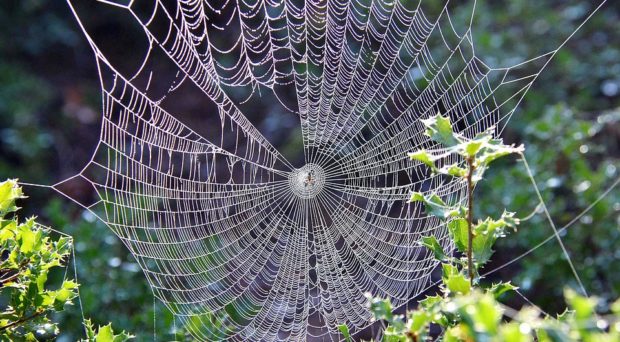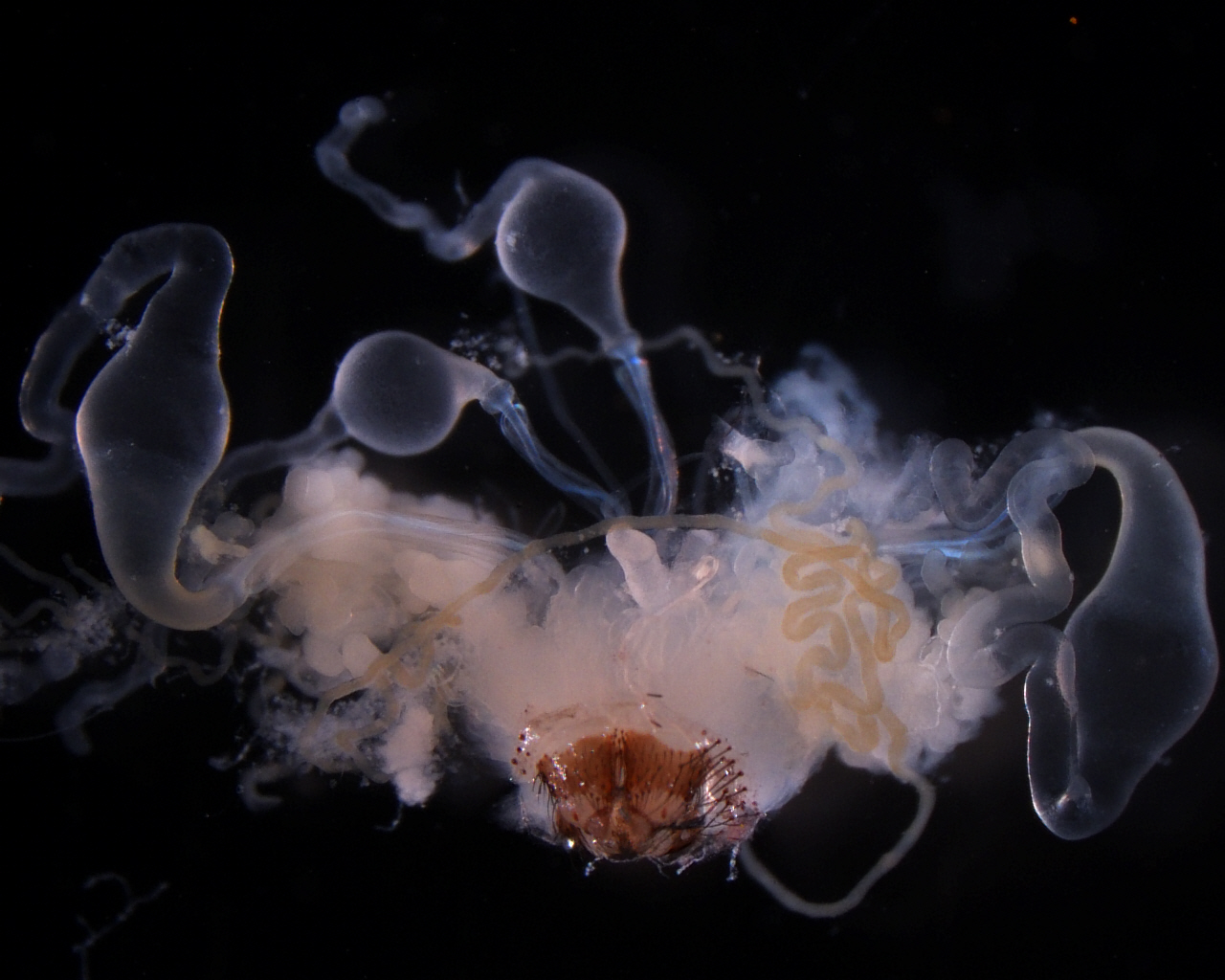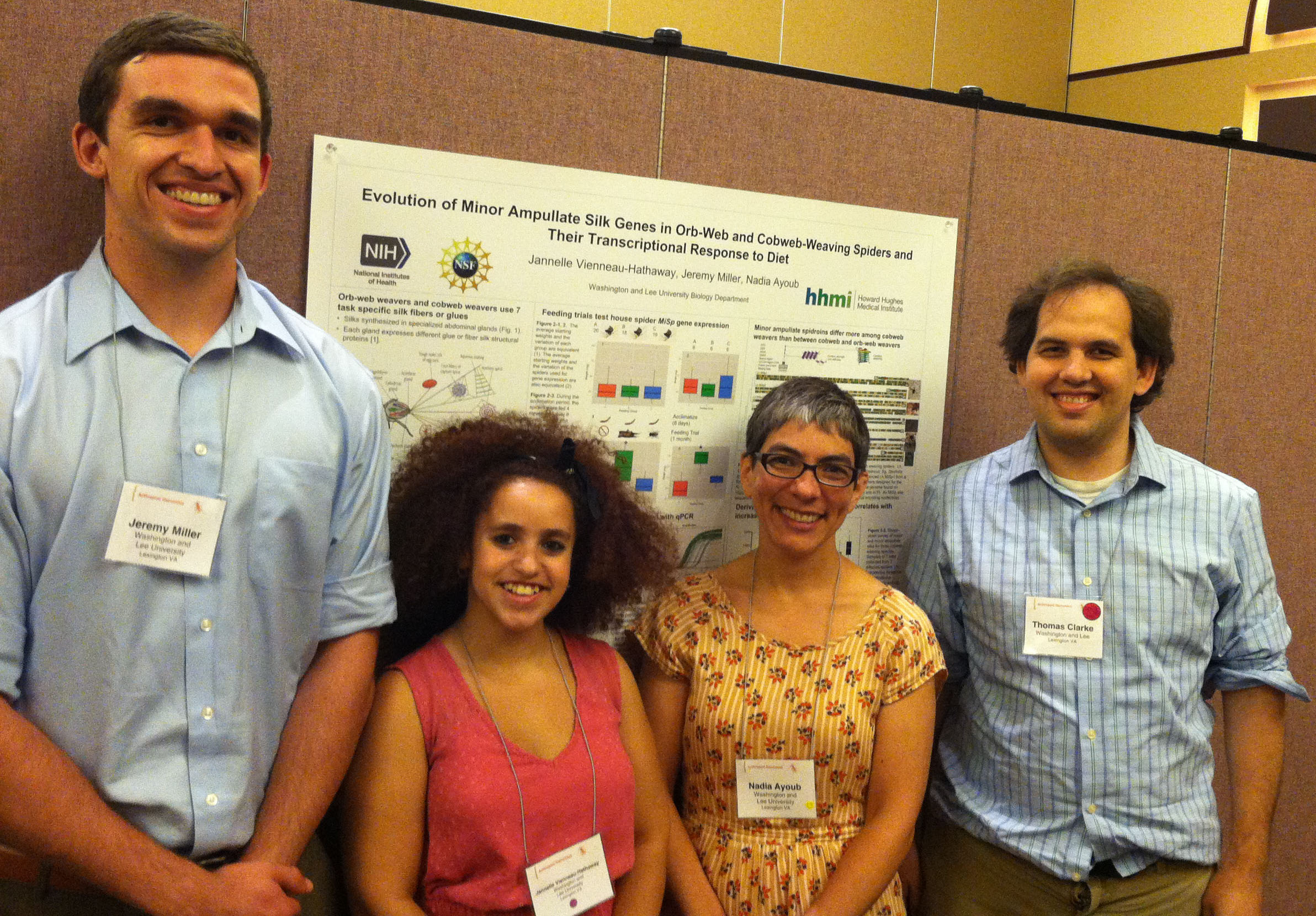
Walking through a spider web in the woods or sweeping out the silk from the corners of your house may seem like a pesky nuisance, but these tenacious webs are engineering feats. The majority of the cobweb, the frame of the orb-web, and the nearly invisible spider lifeline are all made of one type of spider silk that can have tensile strength rivaling steel. This is the major ampullate silk, named after the specialized abdominal gland in which it is synthesized. In terms of toughness, or the total amount of energy required to break, major ampullate silk outperforms steel and Kevlar. Consequently, it has been a prime target for human applications, with some textiles near production.
Even more remarkable is that spiders do not produce just one silk type, unlike the silk moth caterpillars whose cocoons we use to make silk cloth. Instead, an orb-web weaving garden spider or cobweb weaver like the black widow make at least seven types of silk in as many morphologically distinct silk glands.

The material properties of each of these silks appear to be tailored to their ecological functions. For instance, spiders cover their eggs with tubuliform silk, which in garden spiders is stiffer than any other silk type. Egg sacs are thus resistant to pressure that could crush the eggs. The aciniform silk used to wrap prey by garden spiders is the toughest of its silk types, withstanding the energy output of a struggling insect.
Orb-web weaving spiders use minor ampullate silks as temporary capture spirals, which are not as strong as draglines but are equally tough due to their higher stretchiness. Alternatively, black widow spiders use minor ampullate silk to wrap prey, but material properties from this species were previously unknown. My colleagues and I predicted that black widow and other cobweb weaver minor ampullate silks would have divergent material properties from orb-web weavers in part due to their varying functions. We further predicted that the DNA sequences of the genes encoding the minor ampullate silk proteins would differ between orb-web and cobweb weaving spiders.
Sequencing spider silk genes in undergraduate courses
Each type of spider silk is primarily made of one or more unique proteins that are collectively called spidroins (spider fibrous proteins). Spidroins and insect silk proteins share the property of being long (typically >2000 amino acids) and repetitive (short sequences of amino acids could repeat 10-100s of times). Spidroins are thus notoriously difficult to completely sequence.
My colleagues and I have been using a combination of approaches to characterize spidroins. Undergraduate students started helping me collect these data when I was a post-doctoral researcher at the University of California, Riverside in Cheryl Hayashi’s lab. When I took a tenure-track job at Washington and Lee University I decided to scale up undergraduate involvement.
Each year in my Genetics Lab, 17-24 students tackle a new spider species. For our research on minor ampullate silks, recently published in BMC Evolutionary Biology, encoding gene sequences were characterized by three different cohorts. Three students continued working with me in the summers and ultimately became the first three authors on our publication.

Variation in minor ampullate silk proteins correlates with variation in silk properties
After years of sequencing spider silk genes, we discovered unexpected diversity of minor ampullate silk proteins. Not only did orb-web weaver sequences differ from cobweb weavers’, dramatic differences were also found among cobweb weavers. Even more surprising was that each species’ genome included multiple genes encoding minor ampullate silk proteins, and these sequences were often strikingly different.
As an example, the brown widow (invasive in the United States), has one minor ampullate gene that encodes a protein only 815 amino acids long and includes “motifs” typical for minor ampullate proteins: e.g. glycine-alanine repeats. Another brown widow gene encodes a minor ampullate protein more than double the size of the first (1791 amino acids) that is riddled with glycine-proline-glycine. Proline tends to make a kink in proteins. Thus many glycine-proline-glycine iterations form spring-like spirals, which should make the protein elastic.
The false black widow’s minor ampullate proteins were the most proline-rich. Their minor ampullate silks were correspondingly twice as extensible as the minor ampullate silks of the black and brown widow. Overall, cobweb weaver minor ampullate silks were more extensible, but not as strong as orb-web weaver silks.
Leveraging cobweb prey wrapping proteins for human applications
Our sequencing methods resulted in minor ampullate-encoding genes isolated in a format that would facilitate expression of pure protein. Our work could thus contribute to efforts to spin artificial fibers with custom-made properties. For instance, the proline-containing brown widow minor ampullate spidroin could be used to make extensible fibers incorporated into artificial tendons or ligaments. The longer alanine-rich black widow proteins may make stiffer fibers.
Co-author websites:
Nadia Ayoub https://www.wlu.edu/directory/profile?ID=x8123
Jessica Garb https://blogs.uml.edu/garb-lab/
Kelly Lane https://www.genetics.uga.edu/directory/kelly-lane
Comments